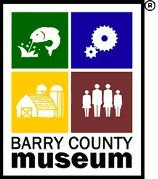Mano
 |
School Group at Mano 1904 |
Mano History by Edith Davis from Back to Barry The first church was built of native logs by its members in 1870 and was named Rock Creek Missionary Baptist Church. In 1905 (35 years later) a new frame building was erected, and painted white. It too, was built by volunteer labor. Ambrose Towler quarried the stone for the foundation . The two acres of land the church purchased from the Railroad Co. The first Minister was Ed Chappell and the deacons were: Hedgepeth Holman, Monroe Aldridge and William Edie. The church was lighted by kerosene lamps on the wall and heated by a pot-bellied wood stove. Sunday School was held weekly but preaching services were conducted once a month with services beginning at 2:00 Saturday afternoon. Sunday at 11:00 a.m. and evening services at early candle light. The church building was sold May 19, 1980 for a home and the money was given to the Rock Creek Cemetery now called Mano Cemetery. William Holman gave the land for the cemetery. The first man buried in the cemetery was murdered. The first school was north of the Harvey Aldridge place near the Aldridge Cemetery and the Post Office was on the Chris Munday Farm. |
East Fork School at Rock Creek |
In 1894 a school house was built at Mano that we know now. Danny Beck built the school house with the help of local patrons. They had 4 months of school. Mollie McCary was the first teacher. Her salary was $25.00 per month. She paid $10.00 per month for room and board to Hedgepeth Holman. The enrollment grew to 60 scholars. The district divided and Eastfork School was built and farther on Accident School House was built. |
 |
Sammy Gilmore, resident of Mano, 38 inches tall |
| Sammy Gilmore built a store near the school at Mano about 1895. The post office was moved to the store. Sammy Gilmore was a man of small stature (about 38 inches tall). He was the constable, Justice of the Peace, Postmaster and merchant. Among the first families living at Mano were: Aldridge, Meadows, Munday, Shaffer, Andrews, Stever, Butron, Pridgett, Allison, Brock, Towler, Strait, Chanler, Edie, Williamson and Holman. David Edie was well known for his blacksmith shop and his excellent work as a carpenter. He also made caskets. George Stever and son Ota were well known for their molasses and they made from sorghum cane. People came from afar to buy the molasses. There was a ferry boat which connected theroad between Mano and Golden. The people wanting to cross the ferry would ring a large bell, which was by ' the ferry, and Mr. Hoagland who owned the ferry would come and set the people across the river. In 1928 a bridge was built across White River and the ferry was no longer needed. People drove their cattle to market at Cassville. Will Edie threshed wheat and oats for people in the community, using a gas engine with fly wheels to power the machine and also sawed wood using the same engine. The equipment was moved by horses. He also had a grist mill and ground cornmeal. For entertainment they conducted debates and kangaroo court at the school house and held music parties in the homes. Arthur Stever often played the mandolin, banjo and dulcimer at these parties. Wells were dug by hand. Fences were built using rocks or rails. Roads were built by the use of graders and slips being drawn by horses. There is a legend that Mano received its name when two people were giving directions on how to go there. When one said, "You may know or you may not know when you arrive there," the two decided, "That's a good name for this place, Mano." In a letter dated July 5, 1878, Jack Stever wrote a letter to his brother James stating that bacon was worth 5 cents a pound, wheat 60 cents a bushel, corn 25 cents a bushel and that he had attended the Murphy Picnic in Barry County. |
|
|


